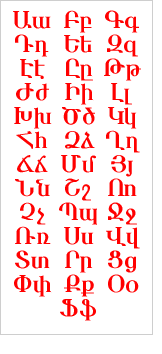|
Armenian Alphabet
(38 letters, upper and lower cases) Silver Binding
Thirteenth Century |
Invention of Armenian Alphabet Early in the fourth century, Gregory the Illuminator, a patrician educated at Caesarea, persuaded the Armenian king to accept Christianity, and Armenia accepted the faith as her national religion. Because the Armenians had no alphabet of their own, liturgical Greek was used in the northwestern part of the country, and Syriac in the southeastern. It can be seen from this that the dual influences of Greece and Persia, each of which would always affect the parts of the country geographically closest to them, were at work. By 404, an Armenian alphabet, created by Saints Sahag and Mesrob, was completed, and soon after translation of the Bible, from the Syriac version, began. Not completely satisfied with the Syriac translation, Mesrob and his disciples reworked their translation, this time using the Greek Septuagint. Commenting on the result, Frederick Greene says: "The ancient Armenian version of the Bible… has been called the queen of versions for its beauty and, though not based on the Hebrew, is of some critical value in determining the readings of the Septuagint, of which it does not follow any known recension…" With the translation of the Bible completed, the fathers turned their attention to liturgical books. And soon church services were being conducted wholly in Armenian. During the "golden age" of the fifth century, works of many Christian patristic writers were translated, including those of Ignatius of Antioch, Irenaeus of Lyons, Hippolytus of Rome, Dionysius of Alexandria, Eusebius of Caesaria , Gregory of Nazianzus, Gregory of Nyssa, Basil the Great, John Chrysostom, Evagrius Ponticus, Cyril of Alexandria and many others. Translation was not confined to the works of Christian writers; the matenadaran manuscript library in Yerevan contains more than 300 manuscripts of Aristotle's work; and the only extant version of Zeno's treatise on nature is the Armenian one. Armenian church fathers of the fifth century were well aware of the attacks and inroads made on Christianity by the pagan philosophers and by heretical members of the Church itself. Enid of Kolb's refutation of the Sects is a good example of Armenian apologetic writing of the time, and is valuable to scholars for the information it gives on the Mazdean religion of the Persians and on the Marcionite heresy. Such apologetical writing continued; the seventh-century treatise on the iconoclasts by Vertanes Kertogh is "the first written document preserved in defense of the veneration on images in the Christian Church." |








